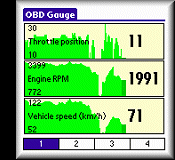Diagnostics and OBD II
 Diagnostics is the in-built self checking facility (OBD - On Board Diagnostics) that has been built into ECUs since the '80's. The original systems were very simple, for example illuminating a warning lamp if a sensor was detected as an open or short circuit. The light, often known as
the MIL (Malfunction Indicator Light) or "Check engine" light would require the driver to take the vehicle to an authorised service station which could interrogate the ECU further as to the trigger of the MIL. Many early ECUs would display a Fault Code by flashing either the MIL indicator, or sometimes an inbuilt
warning lamp on the ECU (as seen on early Honda vehicles, for example), or outputting a pulsed signal to a Diagnostic connector, which could be read by either a test lamp, or a purpose made code reader. These pulsed signals would relate to numbers, which would then be cross referenced in a handbook to find the meaning.
The next major phase in Diagnostic technology was introduced due to legislation from CARB (California Air Resources Board) in 1988, which required all new vehicles sold in California to have an On Board Diagnostic System. Due to the roll-out of this technology for the US market, many Global manufacturers introduced this to all other non US market vehicles.
At this time, there were no standards set for data protocols, or connection types, so codes would often need to be read by the Manufacturer's Diagnostic tools, or expensive Multi-platform Diagnostic tools which were available to Service centres that could deal with many different makes. See also our Scan Tools page.
Diagnostics is the in-built self checking facility (OBD - On Board Diagnostics) that has been built into ECUs since the '80's. The original systems were very simple, for example illuminating a warning lamp if a sensor was detected as an open or short circuit. The light, often known as
the MIL (Malfunction Indicator Light) or "Check engine" light would require the driver to take the vehicle to an authorised service station which could interrogate the ECU further as to the trigger of the MIL. Many early ECUs would display a Fault Code by flashing either the MIL indicator, or sometimes an inbuilt
warning lamp on the ECU (as seen on early Honda vehicles, for example), or outputting a pulsed signal to a Diagnostic connector, which could be read by either a test lamp, or a purpose made code reader. These pulsed signals would relate to numbers, which would then be cross referenced in a handbook to find the meaning.
The next major phase in Diagnostic technology was introduced due to legislation from CARB (California Air Resources Board) in 1988, which required all new vehicles sold in California to have an On Board Diagnostic System. Due to the roll-out of this technology for the US market, many Global manufacturers introduced this to all other non US market vehicles.
At this time, there were no standards set for data protocols, or connection types, so codes would often need to be read by the Manufacturer's Diagnostic tools, or expensive Multi-platform Diagnostic tools which were available to Service centres that could deal with many different makes. See also our Scan Tools page.
In 1994, the CARB released the specifications for OBD II, in association with recommendations from the SAE (Society of Automotive Engineers) which required vehicles to fulfill a number of criteria, such as -
A standardised 16 Pin OBD II connector, situated within reach of the driver's seat. A "Check engine" light. Pre- and Post-Catalytic converter Lambda sensors, to monitor the efficiency of the Catalytic converter. A standardised communication protocol, which would related to DTCs (Diagnostic Trouble Codes) of a mostly standard format.
The standardisation of the plug to the OBD II (SAE J1962) and of communication protocols allowed electronics manufacturers to develop low cost Fault code readers that could read the OBD II DTCs. Note that the OBD II codes were limited in their coverage, usually only concerned with emission control, so they will not be able to diagnose errors in ABS braking or Airbag/SRS systems. In 2001, the EOBD - European On Board Diagnostics protocol was introduced into European Petrol engined vehicles. Whilst this is based on the OBD II standards in the US, it is important to note that European petrol engined vehicles before 2001 may or may not communicate with the OBD2 type code readers. Many of these pre '01 ECUs were identical to the US full OBDII versions, due to the lack of active legislation, they might not have the J1962 OBDII 16 pin connector, or an active "Check Engine" MIL. Remember to check with your tool supplier to see if your vehicle is supported BEFORE you buy!

Above you can see a schematic for the J1962 connector, and although protocols for communication were standardised, there were more than one allowed. Current communication protocols are -
SAE J1850 PWM - Pulse Width Modulation, as used by Ford SAE J1850 VPW - Variable Pulse Width, as used by General Motors ISO 9141-2 - Used in most European and Asian market cars, often referred to as ISO ISO 14230 - Also known as KWP2000 (KeyWord Protocol) ISO 15765 CAN - Controller Area Network. This latest protocol is now part of US regulations, and is used by most manufacturers for Diagnostic and data-bus communication
The CAN bus system employed in modern vehicles acts in a similar way to a Radio channel. The CAN bus connects all modules, which are free to receive and broadcast data packets, which will be listened to and acted upon by anything concerned. CAN speeds can reach up to 1 Mbit/s, with devices transmitting information based on a priority ranking system. For more information on what Scan Tools are available for your car, check out our Scan Tools page.